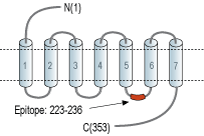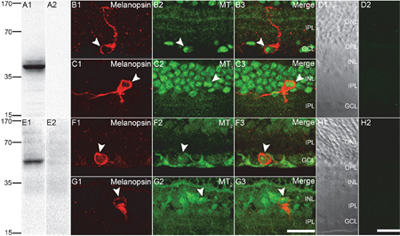Overview
- Peptide (C)RVKPDNKPKLKPQD, corresponding to amino acid residues 223-236 of mouse MTNR1A (Accession Q61184). 3rd intracellular loop.

 Western blot analysis of mouse brain (lanes 1 and 4), rat brain (lanes 2 and 5) and rat cerebellum (lanes 3 and 6) lysates:1-3. Anti-Melatonin Receptor 1A (MTNR1A) Antibody (#AMR-031), (1:200).
Western blot analysis of mouse brain (lanes 1 and 4), rat brain (lanes 2 and 5) and rat cerebellum (lanes 3 and 6) lysates:1-3. Anti-Melatonin Receptor 1A (MTNR1A) Antibody (#AMR-031), (1:200).
4-6. Anti-Melatonin Receptor 1A (MTNR1A) Antibody, preincubated with Melatonin Receptor 1A/MTNR1A Blocking Peptide (#BLP-MR031).
 Expression of Melatonin receptor type 1A in rat supra-chiasmatic nucleusImmunohistochemical staining of rat supra-chiasmatic nucleus (SCN) with Anti-Melatonin Receptor 1A (MTNR1A) Antibody (#AMR-031). A. MT1 staining is restricted to the SCN (red). B. DAPI is used as the counterstain (blue). C. Merge of A and B.
Expression of Melatonin receptor type 1A in rat supra-chiasmatic nucleusImmunohistochemical staining of rat supra-chiasmatic nucleus (SCN) with Anti-Melatonin Receptor 1A (MTNR1A) Antibody (#AMR-031). A. MT1 staining is restricted to the SCN (red). B. DAPI is used as the counterstain (blue). C. Merge of A and B.
Rat dispersed myocytes (Xu, Z. et al. 92019) Eur. J. Pharmacol. 842, 177.).
- Luchetti, F. et al. (2010) FASEB J. 24, 3603.
- Zawilska, J.B. et al. (2009) Pharmacol. Rep. 61, 383.
- Hardeland, R. (2009) Biofactors 35, 183.
- Altun, A. and Ugur-Altun, B. (2007) Int. J. Clin. Pract. 61, 835.
Melatonin (N-acetyl-5-methoxytryptamine) is a product of tryptophan metabolism. It is synthesized in the pineal gland and is secreted to control the circadian rhythm1-3. Melatonin is also synthesized in the gastrointestinal tract, retina, skin and other tissues where it acts in a autocrine or paracrine manner. The role of melatonin in these tissues is independent of its role in the circadian rhythm, where it plays a role in energy metabolism, physiological growth, differentiation and responsiveness in stress stimuli1. The pleiotropic effects of melatonin have given rise to various therapeutic possibilities for this molecule. For example; anti-stress, sexual dysfunction, obesity, gallbladder stones1,4. To date, the only therapeutic uses for melatonin remain to treat sleep disorders, depression, migraine and headaches1.
Melatonin exerts its effects through two G-protein coupled receptors (GPCRs); melatonin receptor type 1 and melatonin receptor type 2 (MT1 and MT2). Like all GPCRs, they have seven transmembrane domains and extracellular N-terminal and cytoplasmic C-terminal tails. The binding of melatonin to either receptor activates Gi, thereby activating PLC, thus increasing intracellular Ca2+ levels. Both receptors structurally bind melatonin in the same manner, although MT2 displays a much higher affinity for the hormone. Just like melatonin levels are detected in many tissues, the expression patterns of the two receptors are also quite broad. For example, MT1 is detected in the brain, retina and kidneys and MT2 is expressed in brain and in the retina1.
MT1 is involved in sleep regulation and might also have effects on peripheral vasoconstriction. MT2 may play an important physiological role in the retina and might regulate body temperature1.
Application key:
Species reactivity key:
Anti-Melatonin Receptor 1A (MTNR1A) Antibody (#AMR-031) is a highly specific antibody directed against an epitope of mouse MT1. The antibody can be used in western blot and immunohistochemistry applications. It has been designed to recognize MT1 from human, rat, and mouse samples.

Expression of MT1 in rat retina.Immunohistochemical staining of rat retinal sections using Anti-Melatonin Receptor 1A (MTNR1A) Antibody (#AMR-031). MT1 staining (green) is restricted to the cytoplasm of retinal ganglion cells.Adapted from Sheng, W.L. et al. (2015) PLoS ONE 10, e0117967. with permission of PLoS.
Applications
Citations
 Expression of MT1 and MT2 receptors in rat retina.A1-E2: Western blot analysis of rat retina lysate: A1. Anti-Melatonin Receptor 1A (MTNR1A) Antibody (#AMR-031). A2. Anti-Melatonin Receptor 1A (MTNR1A) Antibody preincubated with the control peptide antigen. E1. Anti-Melatonin Receptor 1B (MTNR1B) Antibody (#AMR-032). E2. Anti-Melatonin Receptor 1B (MTNR1B) Antibody preincubated with the control peptide antigen. B1-H2: Immunohistochemical staining of rat retina sections using Anti-Melatonin Receptor 1A (MTNR1A) Antibody (#AMR-031) (B2, B3, C2, C3) and Anti-Melatonin Receptor 1B (MTNR1B) Antibody (#AMR-032) (F2, F3, G2, G3). Melatonin receptor expression (green) coincides with that of melanopsin in ipRGCs (red). Note that detection of both receptors is abolished when the antibody is preincubated with the control peptide antigen (panels D2 and H2).
Expression of MT1 and MT2 receptors in rat retina.A1-E2: Western blot analysis of rat retina lysate: A1. Anti-Melatonin Receptor 1A (MTNR1A) Antibody (#AMR-031). A2. Anti-Melatonin Receptor 1A (MTNR1A) Antibody preincubated with the control peptide antigen. E1. Anti-Melatonin Receptor 1B (MTNR1B) Antibody (#AMR-032). E2. Anti-Melatonin Receptor 1B (MTNR1B) Antibody preincubated with the control peptide antigen. B1-H2: Immunohistochemical staining of rat retina sections using Anti-Melatonin Receptor 1A (MTNR1A) Antibody (#AMR-031) (B2, B3, C2, C3) and Anti-Melatonin Receptor 1B (MTNR1B) Antibody (#AMR-032) (F2, F3, G2, G3). Melatonin receptor expression (green) coincides with that of melanopsin in ipRGCs (red). Note that detection of both receptors is abolished when the antibody is preincubated with the control peptide antigen (panels D2 and H2).
Adapted from Sheng, W.L. et al. (2015) with kind permission of Weng, S.J. Institute of Neurobiology, Institutes of Brain Science, State Key Laboratory of Medical Neurobiology and Collaborative Innovation Center for Brain Science, Fudan University, Shanghai, China.
- Rat retina sections.
Sheng, W.L. et al. (2015) PLoS ONE 10, e0117967.
- Rat dispersed myocytes.
Xu, Z. et al. 92019) Eur. J. Pharmacol. 842, 177.
